The dried baby food market is projected to grow from USD 7.6 billion in 2025 to USD 13.5 billion by 2035, with a CAGR of 5.9%. Between 2021 and 2025, the market experiences steady growth, with values increasing from USD 5.7 billion in 2021 to USD 7.6 billion in 2025. This growth reflects the rising demand for convenient, nutrient-rich baby food products, especially as busy lifestyles and the demand for ready-to-eat meals continue to rise. The market reaches a saturation point in 2025 at USD 7.6 billion, where growth begins to slow as a larger portion of the target population adopts dried baby food products.
This period marks the transition from early-stage adoption to mass-market acceptance. From 2025 to 2030, the market continues to grow at a steady pace, rising to USD 10.2 billion by 2030. However, as the market matures, the pace of expansion slows slightly, indicating the saturation of demand in established markets and regions. After 2030, the growth rate stabilizes further, with the market reaching USD 13.5 billion by 2035. The saturation point becomes more evident as growth is driven by incremental innovations, regional expansions, and market penetration in emerging economies.
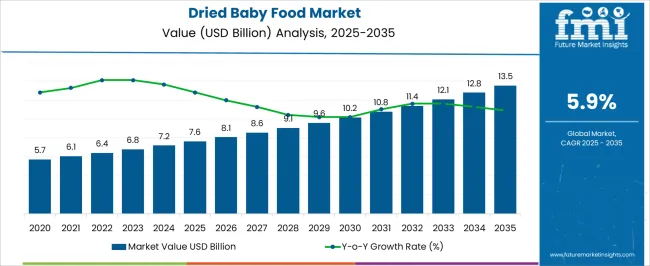
| Metric | Value |
|---|---|
| Dried Baby Food Market Estimated Value in (2025 E) | USD 7.6 billion |
| Dried Baby Food Market Forecast Value in (2035 F) | USD 13.5 billion |
| Forecast CAGR (2025 to 2035) | 5.9% |
The dried baby food market is shaped by several parent markets that contribute to its growth and demand across various sectors. The baby food market plays a significant role, accounting for approximately 15-20% of the market share. Dried baby food is an essential segment within this industry, as it offers a convenient, nutritious option for parents seeking easy-to-prepare meals with a long shelf life. In the convenience food market, dried baby food represents about 10-12% of the market share. The growing trend for ready-to-eat and easy-to-prepare meals drives the demand for dried baby food, providing a quick solution for busy parents while ensuring the food retains nutritional value. The organic food market contributes around 8-10% to the dried baby food sector. With an increasing preference for organic and natural foods, dried organic baby food options are becoming more popular among parents who prioritize chemical-free, wholesome nutrition for their infants. The health and wellness food market plays a significant role, accounting for about 7-9% of the market share.
The retail market significantly supports the growth of the dried baby food market, contributing around 12-15% of the market share. Supermarkets, hypermarkets, and online retail platforms provide easy access to these products, making them a convenient option for parents seeking quick and nutritious baby food.
Rising awareness about balanced early-life nutrition, coupled with the growth of dual-income households, has accelerated adoption. The market has been further supported by advances in processing technologies that preserve nutrient content while extending product shelf life.
Manufacturers are expanding product portfolios to cater to diverse dietary requirements and taste preferences, enabling broader consumer reach. Regulatory emphasis on safe, high-quality infant food has strengthened consumer trust and encouraged market expansion. The ability to store and transport dried baby food without refrigeration has made it a preferred option in both developed and emerging markets.
Growing e-commerce penetration has also increased product accessibility, supporting wider distribution. As demand for fortified and allergen-free variants rises, the market is expected to benefit from ongoing innovation and the alignment of product offerings with evolving parental preferences for health, safety, and convenience.
The dried baby food market is segmented by product type, source, age group, distribution channel, packaging type, and geographic regions. By product type, dried baby food market is divided into Dried baby cereals, Dried baby meals, Dried baby snacks and finger foods, Dried fruit and vegetable purees, and Freeze-dried baby food. In terms of source, dried baby food market is classified into Conventional and Organic.
Based on age group, dried baby food market is segmented into 6–12 Months, 4–6 Months, 12–24 Months, and Above 24 Months. By distribution channel, dried baby food market is segmented into Supermarkets and hypermarkets, Specialty stores, Convenience stores, Online retail, Pharmacies and drugstores, and Others. By packaging type, dried baby food market is segmented into Pouches, Jars and bottles, Cans, Boxes and cartons, and Others. Regionally, the dried baby food industry is classified into North America, Latin America, Western Europe, Eastern Europe, Balkan & Baltic Countries, Russia & Belarus, Central Asia, East Asia, South Asia & Pacific, and the Middle East & Africa.
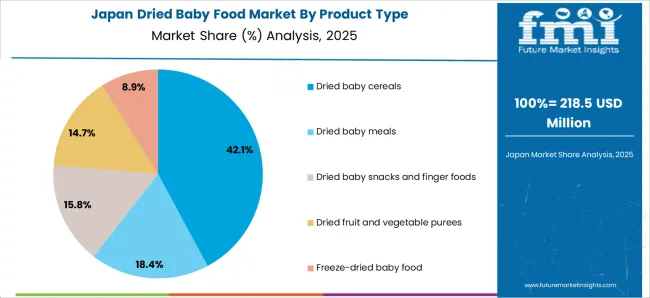
The dried baby cereals segment is projected to account for 42% of the Dried Baby Food market revenue share in 2025, making it the leading product type. Its growth has been supported by the segment’s nutrient-rich composition, which provides essential vitamins, minerals, and energy required for early growth and development.
The ease of preparation and versatility of dried baby cereals have made them a staple in infant diets, particularly during the transition from milk to solid foods. The segment has also benefited from product innovations that enhance taste, texture, and digestibility while meeting safety and quality standards.
The long shelf life and portability of dried baby cereals make them highly convenient for busy parents, contributing to sustained demand. Additionally, their compatibility with various dietary plans and the ability to incorporate functional ingredients have reinforced their appeal in both domestic and international markets, solidifying their dominant position.
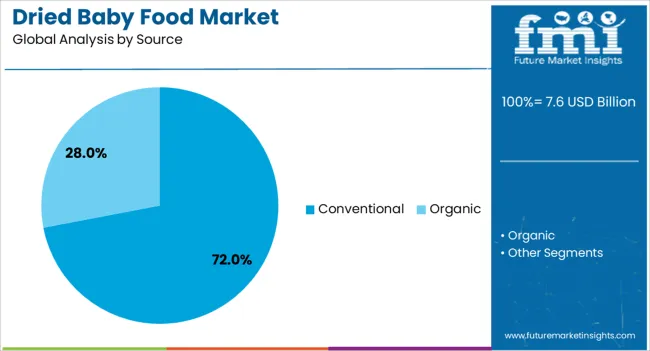
The conventional segment is estimated to hold 72% of the Dried Baby Food market revenue share in 2025, making it the leading source category. Its dominance has been attributed to wider availability, lower production costs, and established consumer familiarity with conventional farming and processing methods. The segment’s accessibility across diverse retail channels has reinforced its position, as it caters to a broad consumer base seeking affordable yet nutritionally balanced baby food.
Conventional dried baby food has also benefited from advancements in preservation techniques that retain flavor and nutrient content without significantly increasing costs. The scalability of conventional production allows for stable supply, meeting consistent global demand.
Additionally, competitive pricing and the presence of trusted brands within this category have strengthened consumer loyalty. While premium and organic options are growing, the conventional segment continues to lead due to its balance of affordability, availability, and nutritional adequacy.
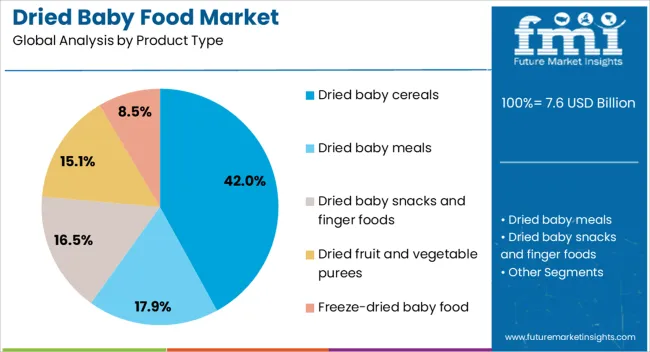
The 6–12 months age group is anticipated to capture 43.30% of the Dried Baby Food market revenue share in 2025, positioning it as the leading consumer age category. This stage marks a critical period of dietary transition, where infants require nutrient-dense solid foods to support rapid growth and cognitive development. Dried baby food products targeting this age range are formulated to provide appropriate textures and nutrient levels, meeting developmental needs while ensuring safety and digestibility.
The segment has gained prominence due to increasing parental focus on balanced nutrition during the complementary feeding phase. Manufacturers have responded with tailored formulations enriched with essential vitamins, minerals, and proteins to support healthy development.
The convenience of dried baby food for this age group, coupled with its portability and long shelf life, has further contributed to its market strength. As awareness of age-specific nutrition grows, this segment is expected to maintain its leadership position.
The dried baby food market is expanding rapidly due to the rising demand for convenient, shelf-stable, and nutritionally balanced food for infants. The growing number of working parents and urban families with busy lifestyles has led to a surge in the adoption of ready-to-eat baby food products, making dried variants an ideal choice. The market offers various products, including dried baby cereals, meals, snacks, and purees, designed for infants between 4–24 months of age. Advancements in food preservation techniques, such as freeze-drying and vacuum packaging, have improved product quality and shelf life. These technological improvements are making dried baby food a more viable and appealing option for modern families.
The dried baby food market faces several challenges that can hinder its growth. One of the primary issues is the perceived lack of freshness when compared to other baby food options such as refrigerated or homemade meals. Many parents prefer fresh, homemade food, believing it offers superior taste and nutritional value. This perception limits the widespread adoption of dried alternatives. The market faces strict regulations regarding food safety, labeling, and ingredient sourcing. Manufacturers must adhere to guidelines set by health organizations to ensure product safety, which can be costly and time-consuming. The market is highly competitive, with a wide range of products available, making it difficult for companies to differentiate their offerings. These challenges require businesses to focus on maintaining quality, innovation, and safety while addressing consumer concerns regarding the freshness and nutritional content of dried baby food.
The dried baby food market is largely driven by the increasing number of working parents, particularly mothers, who seek convenient and nutritious options for their babies. As more mothers join the workforce, the demand for ready-to-use, easy-to-prepare baby food has surged. Dried baby food offers the perfect solution for busy parents, as it can be quickly prepared while providing essential nutrients for infants. Technological advancements in food preservation, such as freeze-drying, have enhanced the quality and shelf life of dried baby food products. The growing awareness about infant nutrition and the need for balanced, safe meals has further propelled market growth. With the rise of modern lifestyles and the demand for healthier food choices, especially among urban families, the market for dried baby food is expected to continue expanding. The ability to provide a convenient yet nutritious solution for busy parents is a key driver of market demand.
The dried baby food market presents various opportunities for expansion. As urbanization continues and the number of working parents grows, the demand for convenient and nutritionally balanced baby food will increase. Manufacturers can tap into this growing need by introducing new product lines, such as organic, non-GMO, or allergen-free options, to cater to the evolving preferences of health-conscious consumers. Additionally, innovations in packaging, such as eco-friendly materials, could attract environmentally-conscious buyers. Expanding into emerging markets, where the demand for packaged baby food is increasing due to growing disposable incomes and changing lifestyles, offers a significant growth opportunity. The partnerships with e-commerce platforms can help increase distribution and accessibility, reaching a wider customer base. As consumer preferences shift toward clean-label products and more transparent ingredient sourcing, companies that focus on offering healthier, high-quality products will be well-positioned to take advantage of these growth opportunities.
The rising demand for clean-label products, where consumers seek transparency in ingredients and sourcing, is influencing manufacturers to produce simpler, healthier options for babies. Additionally, the growing focus on organic and non-GMO ingredients is driving innovation in product development. Technological advancements in food preservation methods, such as freeze-drying, vacuum sealing, and advanced packaging solutions, are improving the quality and shelf life of dried baby food. These innovations ensure that products retain their nutritional value and freshness while maintaining convenience. The increasing demand for personalized baby food solutions, such as age-specific formulations or dietary needs (e.g., gluten-free or vegan), presents opportunities for companies to cater to niche markets. These trends, combined with the increasing preference for ready-to-eat meals, suggest a positive future for the dried baby food market as it adapts to meet consumer needs.
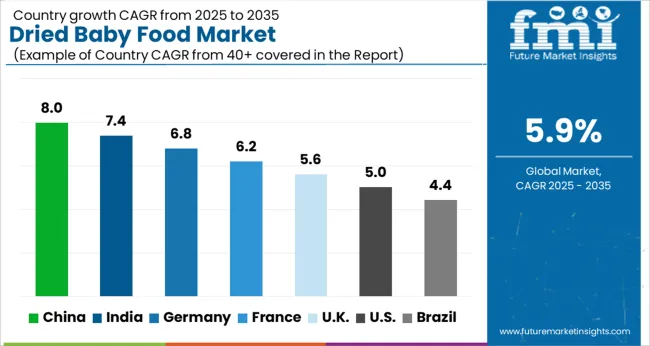
| Countries | CAGR |
|---|---|
| China | 8.0% |
| India | 7.4% |
| Germany | 6.8% |
| France | 6.2% |
| UK | 5.6% |
| USA | 5.0% |
| Brazil | 4.4% |
The global dried baby food market is projected to grow at a CAGR of 5.9% from 2025 to 2035. China leads with a growth rate of 8.0%, followed by India at 7.4%, and France at 6.2%. The United Kingdom and the United States show more moderate growth rates of 5.6% and 5.0%, respectively. The market’s growth is driven by the increasing demand for convenient, nutritious baby food options, supported by the rise in working parents and urbanization. The growing focus on organic, fortified, and healthy baby food further contributes to market expansion across these regions. The analysis includes over 40+ countries, with the leading markets detailed below.
China is expected to lead the dried baby food market with a projected CAGR of 8.0% from 2025 to 2035. The growth is driven by the increasing number of working parents, rising disposable incomes, and the growing preference for convenient and nutritious baby food solutions. China’s expanding middle class and rising awareness about healthy baby food options contribute to market expansion. The country's strong retail presence, both online and offline, ensures easy access to a wide variety of dried baby food products.The growing concerns about food safety further support the demand for trusted and high-quality baby food brands.
The dried baby food market in India is projected to expand at a CAGR of 7.4% from 2025 to 2035. The market is driven by increasing urbanization, higher disposable incomes, and the growing demand for convenient baby food products among working parents. The rise in awareness about the nutritional benefits of dried baby food, coupled with the availability of a wide variety of products, supports continued growth. India’s expanding online retail sector also plays a significant role in driving market demand. Increased health awareness among parents and an emphasis on fortified baby food products further contribute to market growth.
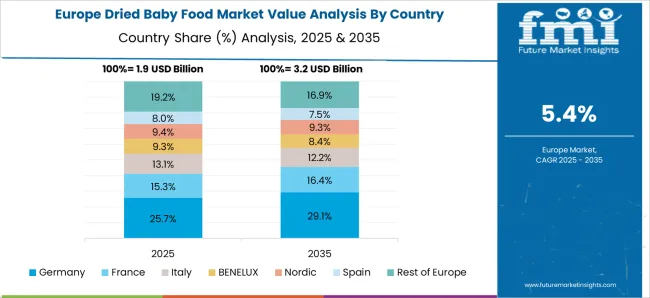
The dried baby food market in France is projected to grow at a CAGR of 6.2% from 2025 to 2035. The increasing preference for natural and organic baby food options, coupled with busy lifestyles, drives the demand for convenient, nutritious dried baby food. France's strong retail infrastructure and focus on food safety standards contribute to the continued growth of the market. Furthermore, as parents become more aware of the nutritional needs of their children, the demand for premium dried baby food products, especially organic and fortified options, is on the rise.
The dried baby food market in the United Kingdom is expected to grow at a CAGR of 5.6% from 2025 to 2035. The UK’s market expansion is driven by the increasing number of dual-income households and rising awareness among parents about the nutritional value of baby food. The shift towards ready-to-eat, easy-to-prepare meals has led to a rise in demand for dried baby food. The focus on organic and fortified products is gaining traction as parents seek healthier, more nutritious food options for their babies.
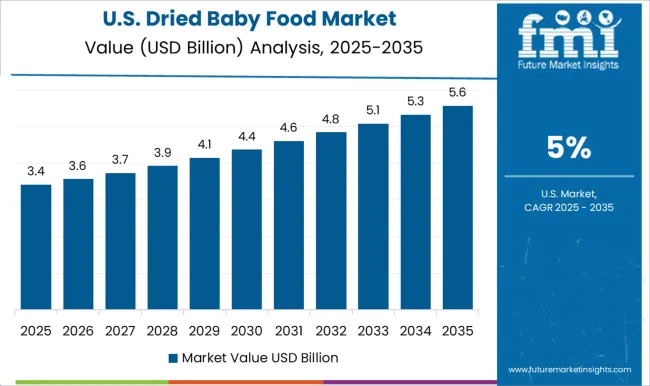
The USA dried baby food market is expected to grow at a CAGR of 5.0% from 2025 to 2035. The market is supported by a growing preference for convenient baby food solutions, particularly in urban areas. As more parents seek easy-to-prepare and nutritious options, the demand for dried baby food products continues to rise. The USA market is influenced by the increasing demand for organic and fortified baby food, as parents become more conscious of the ingredients and nutritional value in their children’s food.
In the dried baby food market, competition is driven by product innovation, nutritional value, and brand loyalty. Nestlé, Danone, and Abbott are the dominant players, offering a wide range of dried baby food products tailored to meet the evolving needs of parents and caregivers. Nestlé leads with a strong portfolio of infant cereals, baby food pouches, and nutritional supplements, focusing on the development of organic and plant-based options. Danone, through its Nutricia brand, emphasizes a commitment to high-quality, scientifically formulated baby foods, particularly in developing markets.
Abbott competes with its Similac and PediaSure brands, which offer nutritional supplements and baby formulas, ensuring strong brand recognition in the market. Strategy across these key players revolves around expanding their product offerings, improving nutritional profiles, and focusing on regional market penetration. Mead Johnson, now part of Reckitt, continues to dominate in the powdered milk formula segment, expanding its presence in emerging markets with customized offerings that address specific regional dietary needs. Kraft Heinz, Hero, and Hain Celestial focus on diversifying their dried baby food lines by offering organic, non-GMO, and allergen-free products, responding to the growing demand for natural and clean-label products.
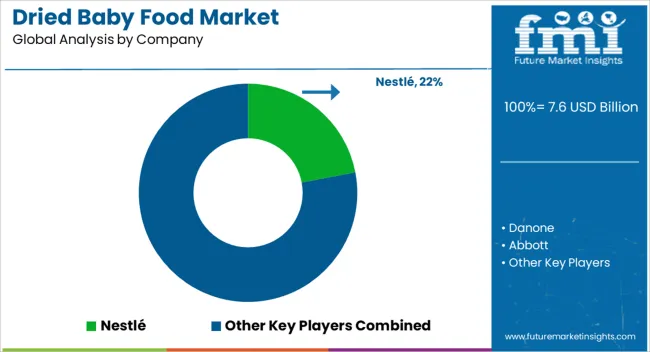
| Item | Value |
|---|---|
| Quantitative Units | USD 7.6 Billion |
| Product Type | Dried baby cereals, Dried baby meals, Dried baby snacks and finger foods, Dried fruit and vegetable purees, and Freeze-dried baby food |
| Source | Conventional and Organic |
| Age Group | 6–12 Months, 4–6 Months, 12–24 Months, and Above 24 Months |
| Distribution Channel | Supermarkets and hypermarkets, Specialty stores, Convenience stores, Online retail, Pharmacies and drugstores, and Others |
| Packaging Type | Pouches, Jars and bottles, Cans, Boxes and cartons, and Others |
| Regions Covered | North America, Europe, Asia-Pacific, Latin America, Middle East & Africa |
| Country Covered | United States, Canada, Germany, France, United Kingdom, China, Japan, India, Brazil, South Africa |
| Key Companies Profiled | Nestlé, Danone, Abbott, Mead Johnson / Reckitt, and Kraft Heinz / Hero / Hain Celestial (others) |
| Additional Attributes | Dollar sales by product type (powdered, ready-to-eat, organic), ingredient type (fruits, vegetables, grains, proteins), and packaging (jar, pouch, tin). Demand dynamics are driven by increasing consumer preference for convenient, nutritious, and organic baby food options, along with growing awareness of infant health and well-being. Regional trends highlight strong growth in North America, Europe, and Asia-Pacific, fueled by rising disposable incomes, urbanization, and evolving parental preferences for premium, natural ingredients in baby food. |
The global dried baby food market is estimated to be valued at USD 7.6 billion in 2025.
The market size for the dried baby food market is projected to reach USD 13.5 billion by 2035.
The dried baby food market is expected to grow at a 5.9% CAGR between 2025 and 2035.
The key product types in dried baby food market are dried baby cereals, dried baby meals, dried baby snacks and finger foods, dried fruit and vegetable purees and freeze-dried baby food.
In terms of source, conventional segment to command 72.0% share in the dried baby food market in 2025.






Our Research Products

The "Full Research Suite" delivers actionable market intel, deep dives on markets or technologies, so clients act faster, cut risk, and unlock growth.

The Leaderboard benchmarks and ranks top vendors, classifying them as Established Leaders, Leading Challengers, or Disruptors & Challengers.

Locates where complements amplify value and substitutes erode it, forecasting net impact by horizon

We deliver granular, decision-grade intel: market sizing, 5-year forecasts, pricing, adoption, usage, revenue, and operational KPIs—plus competitor tracking, regulation, and value chains—across 60 countries broadly.

Spot the shifts before they hit your P&L. We track inflection points, adoption curves, pricing moves, and ecosystem plays to show where demand is heading, why it is changing, and what to do next across high-growth markets and disruptive tech

Real-time reads of user behavior. We track shifting priorities, perceptions of today’s and next-gen services, and provider experience, then pace how fast tech moves from trial to adoption, blending buyer, consumer, and channel inputs with social signals (#WhySwitch, #UX).

Partner with our analyst team to build a custom report designed around your business priorities. From analysing market trends to assessing competitors or crafting bespoke datasets, we tailor insights to your needs.
Supplier Intelligence
Discovery & Profiling
Capacity & Footprint
Performance & Risk
Compliance & Governance
Commercial Readiness
Who Supplies Whom
Scorecards & Shortlists
Playbooks & Docs
Category Intelligence
Definition & Scope
Demand & Use Cases
Cost Drivers
Market Structure
Supply Chain Map
Trade & Policy
Operating Norms
Deliverables
Buyer Intelligence
Account Basics
Spend & Scope
Procurement Model
Vendor Requirements
Terms & Policies
Entry Strategy
Pain Points & Triggers
Outputs
Pricing Analysis
Benchmarks
Trends
Should-Cost
Indexation
Landed Cost
Commercial Terms
Deliverables
Brand Analysis
Positioning & Value Prop
Share & Presence
Customer Evidence
Go-to-Market
Digital & Reputation
Compliance & Trust
KPIs & Gaps
Outputs
Full Research Suite comprises of:
Market outlook & trends analysis
Interviews & case studies
Strategic recommendations
Vendor profiles & capabilities analysis
5-year forecasts
8 regions and 60+ country-level data splits
Market segment data splits
12 months of continuous data updates
DELIVERED AS:
PDF EXCEL ONLINE
Dried Herbs Market Size and Share Forecast Outlook 2025 to 2035
Dried Honey Market Size and Share Forecast Outlook 2025 to 2035
Dried Soup Market Size, Growth, and Forecast for 2025 to 2035
Dried Spices Market Analysis by Type, End-Use Industry, Distribution Channel and Others Through 2035
Dried Spent Grain Market Trends – Growth & Industry Forecast 2025 to 2035
Dried Eggs Market Insights – Shelf-Stable Nutrition & Industry Growth 2025 to 2035
Dried Apricot Market - Growth, Demand & Nutritional Trends
Dried Mushrooms Market Analysis – Trends & Forecast 2024-2034
Dried Distillers' Grains with Soluble Market
Air-Dried Food Market Growth, Forecast, and Analysis 2025 to 2035
Air-dried Fish Dog Food Market Size and Share Forecast Outlook 2025 to 2035
Air-dried Venison Dog Food Market Size and Share Forecast Outlook 2025 to 2035
Air-dried Chicken Dog Food Market Size and Share Forecast Outlook 2025 to 2035
Roll-dried Starch Market Size and Share Forecast Outlook 2025 to 2035
Spray-dried Animal Plasma (SDAP) Market Size and Share Forecast Outlook 2025 to 2035
Spray Dried Food Market Analysis - Size, Share, and Forecast Outlook 2025 to 2035
Freeze Dried Fruit Powder Market Size and Share Forecast Outlook 2025 to 2035
Rolled-Dried Starch Market Size and Share Forecast Outlook 2025 to 2035
Freeze Dried Fruits Market Analysis - Size, Share, and Forecast Outlook 2025 to 2035
Freeze Dried Fruits And Vegetables Market Size and Share Forecast Outlook 2025 to 2035

Thank you!
You will receive an email from our Business Development Manager. Please be sure to check your SPAM/JUNK folder too.
Chat With
MaRIA